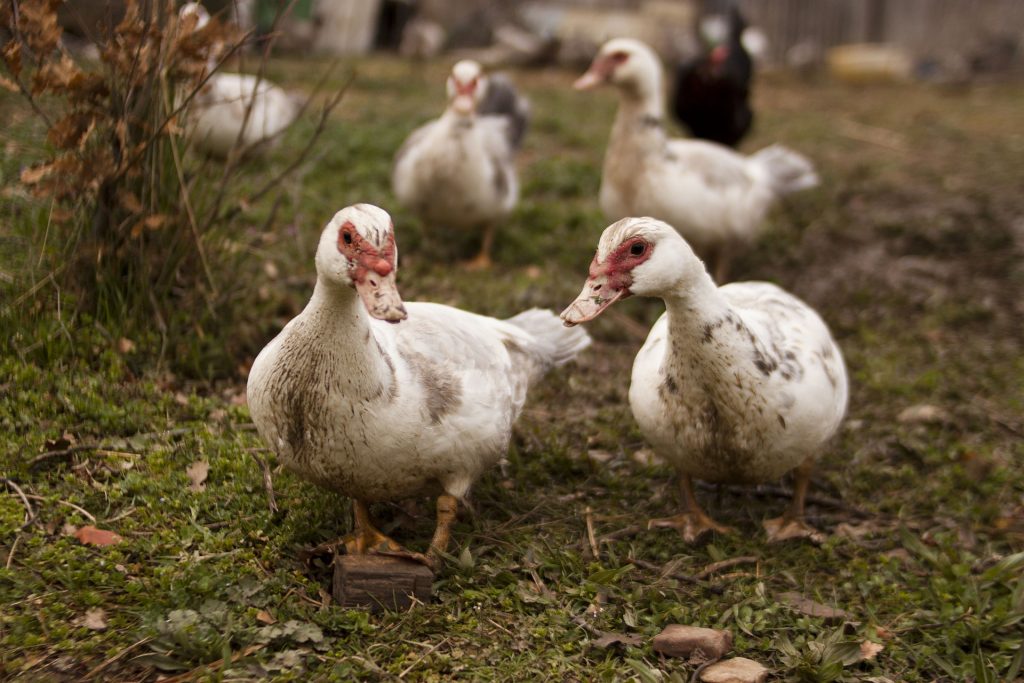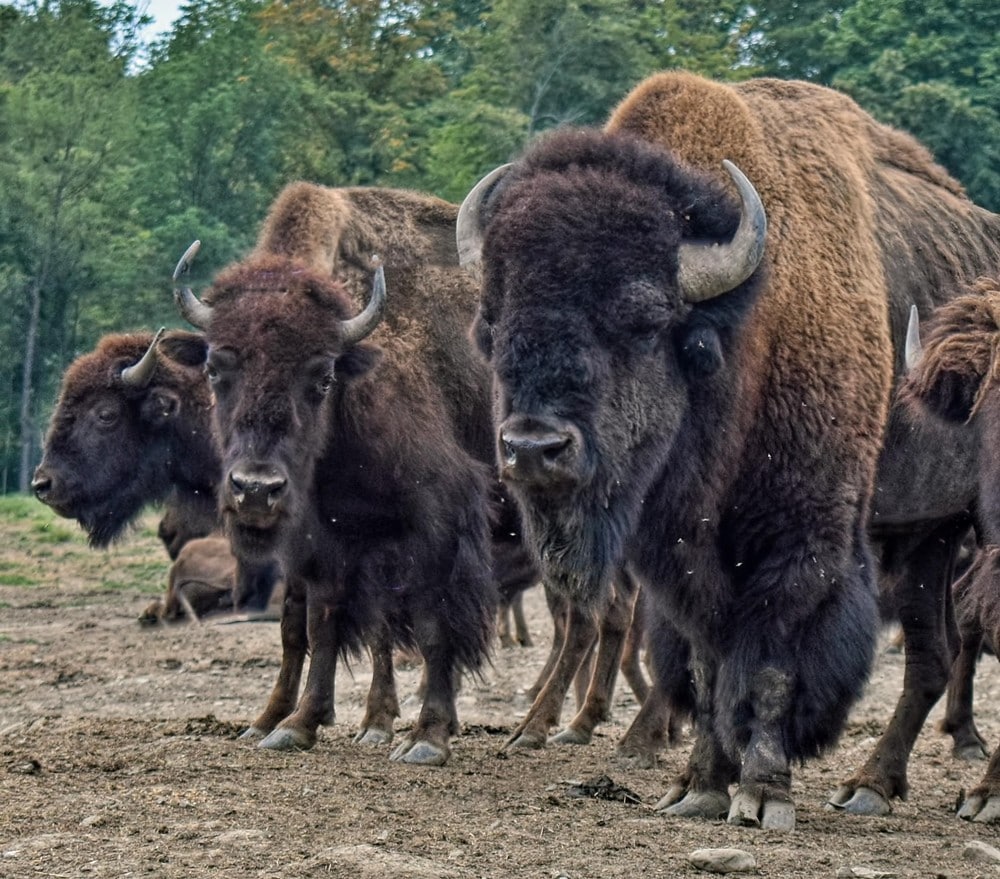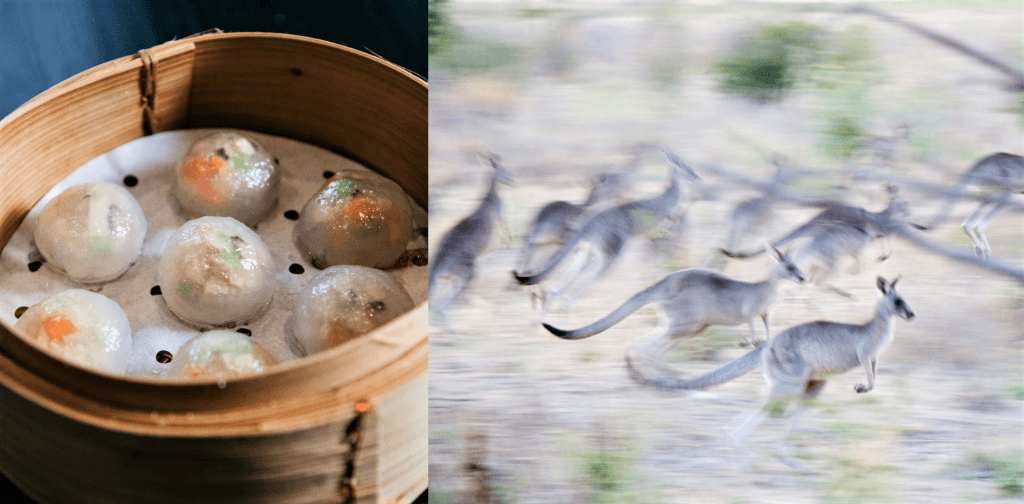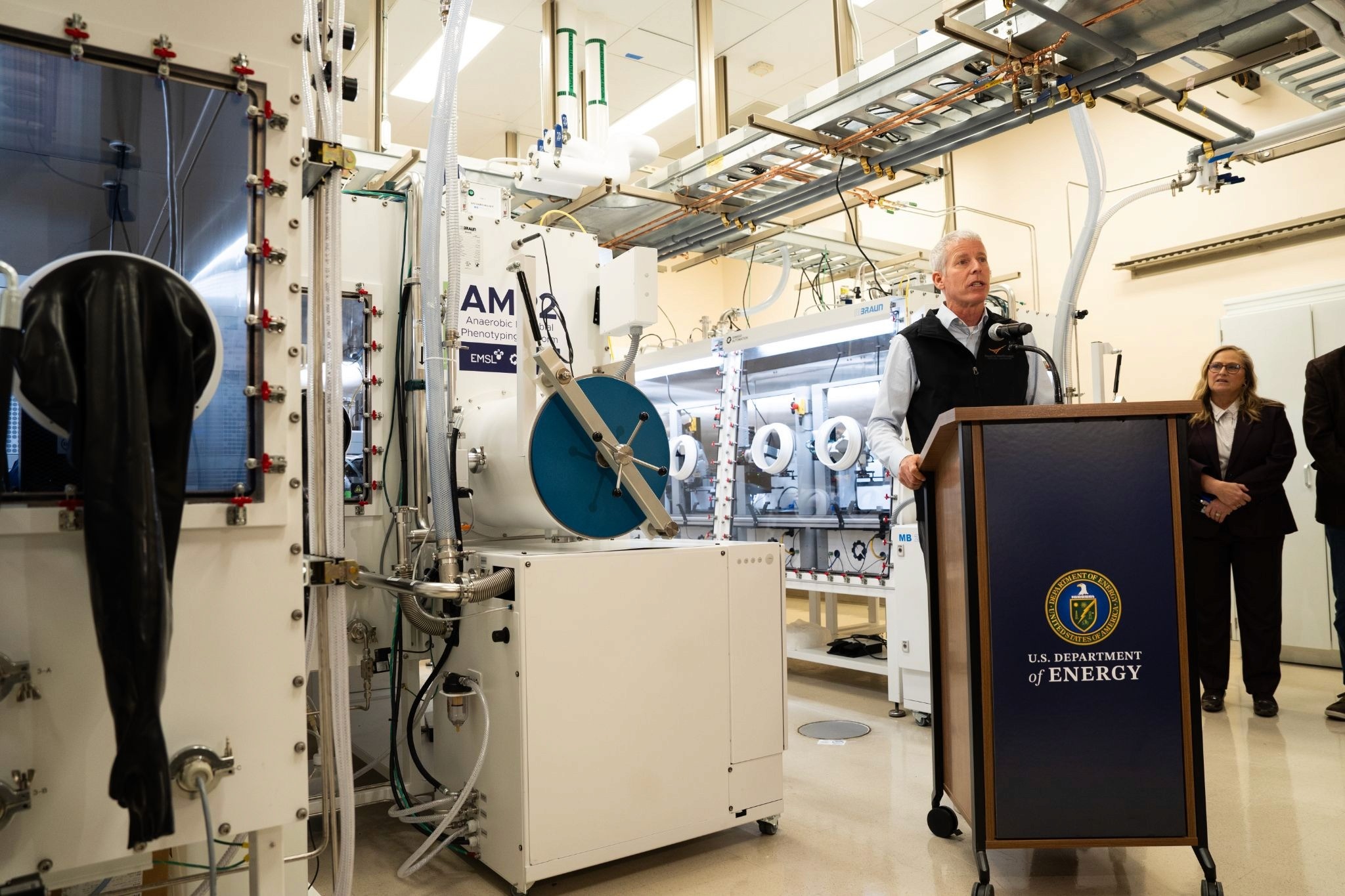Food Agriculture
Next on the Menu: Cellular Agriculture Could “Domesticate” Any Animal on the Planet
May 11, 2021
Goat cheeseburger slider ©Vow Foods
Animal breeding, maintenance, and slaughter have been integral parts of agricultural systems around the world for over 10,000 years. Today, raising livestock generates 14.5% of global greenhouse gas emissions and is associated with the emergence of infectious diseases that jump from animals to humans. As the burden of animal agriculture on the environment and public health increases, animal protein must be produced more sustainably and responsibly to meet global demands. The production of animal products from cells in the lab using synthetic biology and cell culture techniques is known as cellular agriculture. Instead of raising animals, only their cells are needed. This new technology could create opportunities for previously unimaginable sources of animal protein. Cultured kangaroo and alpaca burgers or ethical foie gras made from duck cells are already in the discovery phase. Now, cellular agriculture could offer a wider variety of animal products and create completely new kinds of foods.
The Opportunity for Cultured Meat
Livestock farming clears land, threatens biodiversity, and emits more greenhouse gases than all cars, planes, trains, and ships combined while causing animal suffering and public health risks. It’s a problematic practice and difficult to justify, especially when a more efficient way to obtain these proteins is possible. Today, we can observe, understand, and replicate the biological processes occurring at the cellular level when tissues develop or milk is produced. Growing meat in the lab involves obtaining cells from a particular species and tissue type through a biopsy and developing them in a cell culture medium with essential micronutrients. The cells are then nurtured and grown inside cultivators to form muscle, fat, and connective tissue. So far, the vast majority of cultured meat efforts have gone toward the production of the most common meats, including beef, pork, chicken, fish, and seafood. But as we embark on the next agricultural revolution, we have the opportunity to change not only the way we source meat but also the types of meat we produce.
Luxury Foods Could Become Affordable and Ethical

Farmed ducks are notoriously abused to create luxury delicacies like foie gras. Cell culture technology could stop both animal cruelty and the high price tag of these foods. Image by Aleix Solé from PixabayHistorically, animal welfare concerns and threats of extinction have limited access to meat dishes with cultural and gastronomic significance. But cellular agriculture can reduce barriers, such as cost, and overcome controversial practices to produce luxurious and delicious meats.Foie gras, a popular and well-known dish in French cuisine, is the liver of a duck or goose enlarged to 10 times its usual volume by force-feeding. Due to the unethical production of this specialty, it has been banned in several countries. “This delicious product is going through an existential crisis and it will need to reinvent itself to avoid becoming a relic of the past that more and more consumers will reject,” says Nicolas Morin-Forest, CEO and co-founder of Gourmey, the first French cultured meat company developing ethical foie gras.

The Gourmey team samples some of the world’s first cell-based foie gras. Image: GourmeyAt Gourmey, stem cells are extracted from a freshly laid duck or chicken egg, placed into a cultivator, and fed with basic nutrients. In a suitable environment, these cells can naturally multiply and differentiate into the desired cell type such as muscle, fat, or liver. “If we look at foie gras, we would adjust the cell nutrients and slightly increase the level of healthy plant-based fats to replicate the effect of force-feeding directly at the cell level,” says Morin-Forest. Once fatty liver cells become tissues, they can be cooked with other ingredients to complete the foie gras recipe.Foie gras isn’t the only luxury food seeing new attention through cell culture technology. Maine lobsters, often considered the sweetest and tastiest lobster on the planet, are threatened by overfishing and climate change. Cultured Decadence, a Wisconsin-based startup is working to produce cultured Maine lobster.The company collects tissue samples and isolates individual lobster cells. The cells are then grown in a safe, controlled environment on an edible scaffold to adopt the structure and texture of wild-caught meat. Scaffolding is a key component. Without it, cell-based meats cannot hold the form of a cut of steak or in this case, a lobster tail.Making luxury meats more ethical and affordable through synthetic biology may only be the beginning. Now some entrepreneurs are asking: Can we cultivate healthy and flavorful meats from species that have never been tasted before?
Bringing New Tastes, Flavors, and Textures to the Table
Since cultured meat begins with cells in a bioreactor, meat could theoretically be grown from virtually any animal on the planet. "You've invented this crazy new platform technology, and you can literally make anything you want. You can design unicorn meat, and you chose chicken?" says George Peppou, founder and CEO of Vow, a Sydney-based startup culturing exotic animal meats. Vow is building a proprietary library of cells as the building blocks for novel meats. Many of these cell types come from creatures that were previously overlooked as meat sources. “From these cells, a repertoire of ingredients is created to sell meat either as a single species that we can't farm or as a multi-species blend that offers something really distinct,” says Peppou. So far, Vow's cell library contains 11 different animals, including water buffalo, alpaca, and kangaroo.

The Vow team taste-tests their first novel dishes including cultured goat burgers and kangaroo dumplings. Image: VowBy closely analyzing cells and conducting sensory evaluations of cultured meats, Vow is testing the key molecular components that determine flavor, texture, and nutrition. Because cell development and function vary from species to species, these biological differences and characteristics must be cataloged. “Over time, there's going to be more and more species, more cell types, and more process conditions that we can grow them in,” says Peppou.A library of characterized cells becomes a source of data and raw material for designing foods with new features and flavors. Rather than a traditional food production facility, the company is creating design studios to build a new category of food. These products will be a departure from what has been known as meat for the past few centuries. Peppou wants to approach these foods with a new vocabulary. “We don't want to call it meat, and we don't want to do the same things,” says Peppou. Vow isn’t alone in culturing meats from animals that aren't readily commercialized. Berkeley-based startup, Orbillion Bio, is focusing on a variety of heritage meats, such as wagyu beef, elk, sheep, and American bison. In March, Orbillion Bio held its first public tasting event to present meats mixed with their cultured wagyu beef, elk, and sheep.
The Long Road to Culture(d) Approval
Though cultured meat technology is progressing quickly, there are many challenges for regulatory approval, consumer acceptance, commercial scale-up, and price parity.For cultured meats to be commercialized, they will first need regulatory approval by food agencies. In December 2020, the Singapore Food Agency (SFA) became the first in the world to authorize the commercial sale of cultured chicken. Other food authorities are expected to follow, but conservative regulators may be more reluctant to approve cell-based products.The Food and Drug Administration (FDA) and the U.S. Department of Agriculture's Food Safety and Inspection Service (USDA-FSIS) must develop detailed procedures and provide regulatory oversight of products derived from cultured animal cells. The FDA regulates cell-based product facilities and an extensive pre-market consultation process. The USDA-FSIS takes over the end processes, inspecting establishments where cell cultures are taken and enforcing labeling and other compliance regulations.

American bison are farmed for their meat. Wild bison were almost hunted to extinction but conservation efforts have seen their numbers increase. Cell culture technology could help preserve land for wild herds and eliminate the need to farm these iconic American animals. Image: Jo Zimny, FlickrCompared to cell-based meat from domesticated animals, approval of meat from an exotic species and multiple species is likely to take longer. In Peppou's experience, some regulators expect to prove that cell-based foods are safe in the same way as any other cell line, while others use species-specific meat requirements as the basis for their regulations. He admits that it may be more difficult to approve Vow's products in countries that use the latter standard.According to Peppou, “The novel food pathway in Australia is incredibly flexible and very evidence-driven. At the moment, the regulators believe that pathway is suitable for cultured meat, which is a fantastic thing for them to decide and get comfortable with.” In the U.S., the food approval process may take longer due to strict FDA standards, a lack of political will, and a stronger cattle lobby. In addition to regulatory approval of cultured meats, the adoption of novel cell-based meats depends on the general public. “Cultured foie gras allows us to preserve a culinary heritage and bring it forward to the 21st century,” says Morin-Forest.Morin-Forest says the Gourmey has been focused on understanding consumer perceptions. “We have been engaging directly with different groups of people, mostly on social media where we’ve already had more than 5,000 conversations with very different audiences and the outcomes are highly favorable,” says Morin-Forest. He also points out that authenticity and transparency can enable people to clearly understand explanations of the benefits of cultured meat in terms of sustainability, food safety, or animal welfare. However, most consumer acceptance studies of cultured meat have been conducted without an actual product to taste. It's unclear how public perception may shift when these foods reach the market. Since many manufacturers currently lack the experience and infrastructure to develop cultured meat, many companies in the space may have to develop and scale their products in-house. At Vow, Peppou aims for vertical integration, an arrangement in which a company controls or owns its supply chain. “We have to build our own development-scale facility, if not our first commercial-scale facility, to even come to market and prove the demand,” says Peppou.Gourmey is making similar efforts to lower costs and increase the production of cultured foie gras. Once at scale, Morin-Forest estimates that the process from cell to fork can take as little as three to four weeks, compared to three months from hatching to slaughter in conventional farming. The company aims to offer an ethical foie gras to consumers by 2023 or 2024. Despite the challenges of regulatory approval, consumer acceptance, and commercial scale-up, cell-based agriculture is rapidly moving forward.
The Beginning of Unlimited Flavors?

Kangaroo meat is considered an exotic specialty but kangaroos cannot be domesticated - all kangaroo protein currently comes from hunting these animals in the wild. Cell culture technology looks to limit or end this hunting practice. Left: Kangaroo dumplings by Vow. Right: A wild kangaroo herd (John Schilling, Flickr)For Peppou, defining a new category of food has less to do with tasting specific creatures and more to do with creating rich, new experiences. “Ultimately, it's not about the animal at all. It's about what we can create. With the building blocks in its cell library, Peppou says the company could one day produce the lean muscle protein of a chicken breast with the omega-3 richness of a salmon. If achieved, the possible combinations of flavor and textures of cultured meat could be virtually limitless. As the quality of cell-based meat improves, Peppou expects companies will change the functionality, nutritional levels, flavor, and texture of their meats to stand out. Instead of being faithful replicas of real meat, he predicts that cell-based products will have distinct characteristics, be recognized as a brand, and be described in terms of sensory experience. Beyond the benefits for the environment and food creativity, cultured meat could contribute to our understanding of developmental and cell biology. Studies of biological processes in cellular agriculture could help advance medicine and basic scientific research.According to Morin-Forest, “Reinventing foie gras through cellular agriculture is only the beginning of our journey. It is our way to show that innovation and tradition can go hand in hand.” After foie gras, Gourmey may turn to duck burgers, while Vow is eyeing turtle meat to add to its cell library. We are only at the beginning of what may be a new, cell-based agricultural revolution. The technology could put foods that weren’t commercially available or simply didn't exist on the table. With cellular agriculture, we may not have to compromise the pleasure of eating for ethics and sustainability. One day, we may be able to taste foods we haven’t even dreamed of. Yet.


















